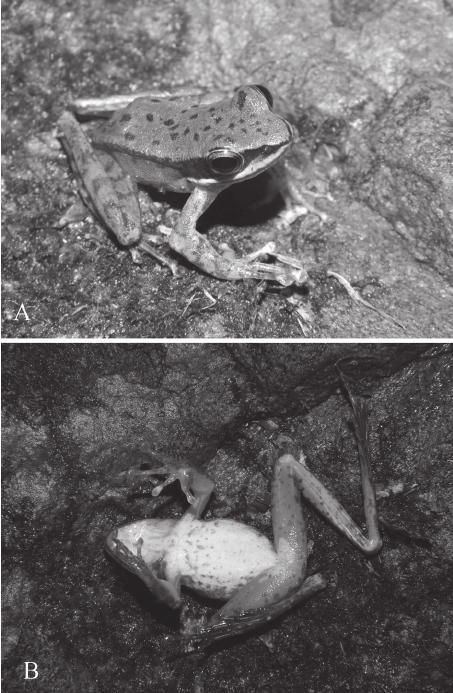| Citation |
|
Description |
Geographic Range [top]
Range Description: This species is currently known only from between 600–1,465 m Asl in Phongsaly Province, northern Laos (Bain et al. 2006), as well as Dien Bien and Son La Provinces in northern Viet Nam (Le et al. 2015). It is possible that the species range extends outside of those areas from which it is currently known; further surveys are warranted and may uncover its presence in adjacent areas. Therefore its range has been projected beyond known sites to include areas of suitable habitat. This species estimated extent of occurrence (EOO) is 10,377 km2, which consists of five threat-defined locations.
Countries occurrence:
Native:
Lao Peoples Democratic Republic; Viet Nam
Additional data:
? Number of Locations: 5
? Lower elevation limit (metres): 600
? Upper elevation limit (metres): 1465
Range Map: Click here to open the map viewer and explore range.
Population [top]
Population: Very little is known about the size of this species population except that it has been detected in only two surveys (Bain et al. 2006, Le et al. 2015). Further surveys are needed to determine its relative abundance. Deforestation continues to affect habitat in the species predicted range (Sodhi et al. 2009), and is very likely causing population declines. Recent satellite imagery shows that the areas of forest around the species known localities are relatively small and are surrounded by cleared agricultural land. Depending on how forest-dependent the species is, these localities probably represent isolated populations. With an area of less than 30 km2 that includes some intervening farmland, the inferred suitable habitat at the species locality in Dien Bien Province, Viet Nam, is particularly restricted.
Current Population Trend: Decreasing
Additional data:
? Population severely fragmented: Yes
Habitat and Ecology [top]
Habitat and Ecology: This species is associated with montane evergreen forest and has mostly been observed on the ground, in herbaceous vegetation approximately one meter off the ground, and up to two meters from the banks of small streams (Bain et al. 2006, Le et al. 2015). Observations of the species have occurred in October in Laos (Bain et al. 2006) and August-October in Viet Nam (Le et al. 2015). Males have been observed calling from above the ground in shrubs (Bain et al. 2006). Eggs are presumably deposited in the same streams around which the males call, as with other Amolops for which the reproductive strategy is known, though this has not been documented.
Systems: Terrestrial; Freshwater
Continuing decline in area, extent and/or quality of habitat: Yes
Movement patterns: Not a Migrant
Use and Trade [top]
Use and Trade: There are no reports of this species being utilized.
Threats [top]
Major Threat(s): Habitat loss and degradation due to the effects of rapidly expanding agriculture is an ongoing threat to biodiversity throughout Viet Nam, including within much of this species range (Sodhi et al. 2009). Recent satellite imagery shows that this species known localities are surrounded by cleared agricultural land. The degree to which this species is forest-dependent this species is unclear. However given that it is rarely observed and is currently only known from within protected forests (Bain et al. 2006, Le et al. 2015), it is likely threatened to some degree by habitat loss.
Conservation Actions [top]
Conservation Actions: Conservation Actions
This species is currently only known from three protected areas: Phou Dendin National Biodiversity Conservation Area in Laos (Bain et al. 2006), and Muong Nhe and Copia Nature Reserves in Viet Nam (Le et al. 2015).
Conservation Needed
Addressing the lack of data is the first step towards ensuring this species long-term persistence. Increased protection of some of the species known localities may be needed to safeguard against habitat encroachment.
Research Needed
Further research on its true distribution, threats, the size and trends of its population would inform conservation decisions.
Citation: IUCN SSC Amphibian Specialist Group. 2017. Amolops vitreus. The IUCN Red List of Threatened Species 2017: e.T135837A86901318. http://dx.doi.org/10.2305/IUCN.UK.2017-2.RLTS.T135837A86901318.en. Downloaded on 19 October 2018.
Disclaimer: To make use of this information, please check the .
Feedback: If you see any errors or have any questions or suggestions on what is shown on this page, please provide us with feedback so that we can correct or extend the information provided
|

